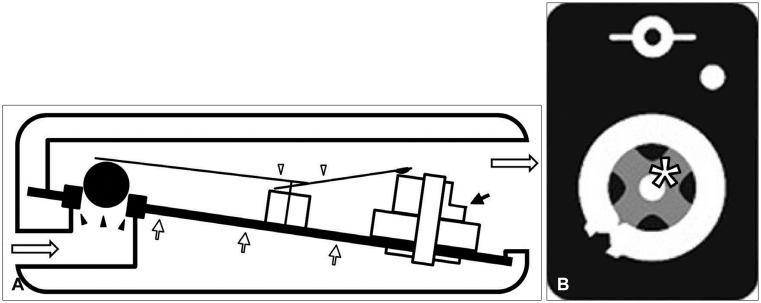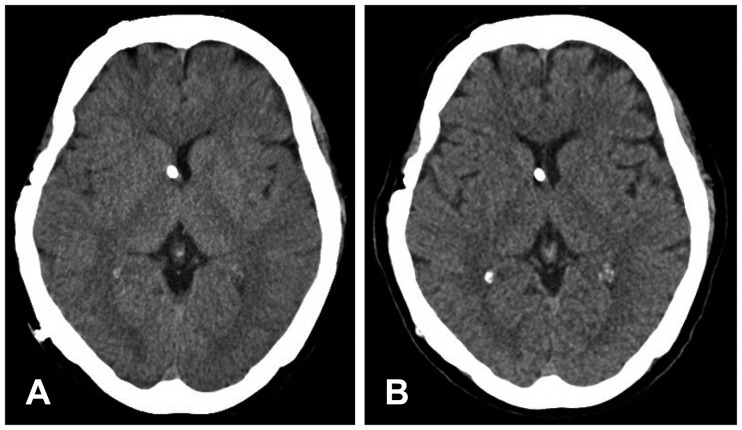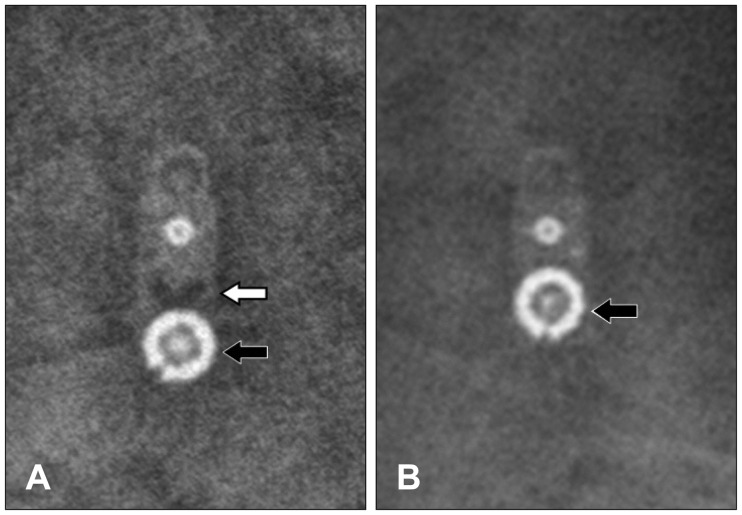Korean J Neurotrauma.
2016 Oct;12(2):163-166. 10.13004/kjnt.2016.12.2.163.
Shunt Overdrainage Caused by Displacement of the Pressure Control Cam after Pressure Adjustment
- Affiliations
-
- 1Department of Neurosurgery, Daegu Fatima Hospital, Daegu, Korea. paulyoonsoolee@hanmail.net
- KMID: 2356794
- DOI: http://doi.org/10.13004/kjnt.2016.12.2.163
Abstract
- Although the Codman-Hakim programmable valve is one of most popular shunt systems used in the clinical practice for the treatment of hydrocephalus, malfunctions related with this system have been also reported which lead to underdrainage or overdrainage of the cerebrospinal fluid. While obstruction of the ventricular catheter by tissue materials or hematoma and catheter disconnection are relatively common, the malfunction of the valve itself is rare. Herein, we report on a rare case of shunt overdrainage caused by displacement of the pressure control cam after pressure adjustment. A 57-year-old female, who underwent a ventriculoperitoneal shunt eight years ago, experienced aggravating symptoms of shunt overdrainage after pressure adjustment. Displacement of the pressure control cam was revealed on the X-ray, and a shunt revision was performed. The purpose of this report is to provide a working knowledge of the valve structure and to enhance the ability to interpret the valve setting on an X-ray for diagnosis of valve malfunction.
MeSH Terms
Figure
Reference
-
1. Black PM, Hakim R, Bailey NO. The use of the Codman-Medos Programmable Hakim valve in the management of patients with hydrocephalus: illustrative cases. Neurosurgery. 1994; 34:1110–1113. PMID: 8084404.2. Kurosaki K, Hamada H, Hayashi N, Kurimoto M, Hirashima Y, Endo S. A rare case of shunt malfunction attributable to blockage of a Codman-Hakim programmable shunt valve. Childs Nerv Syst. 2002; 18:183–185. PMID: 11981632.
Article3. Lollis SS, Mamourian AC, Vaccaro TJ, Duhaime AC. Programmable CSF shunt valves: radiographic identification and interpretation. AJNR Am J Neuroradiol. 2010; 31:1343–1346. PMID: 20150313.
Article4. Okazaki T, Oki S, Migita K, Kurisu K. A rare case of shunt malfunction attributable to a broken Codman-Hakim programmable shunt valve after a blow to the head. Pediatr Neurosurg. 2005; 41:241–243. PMID: 16195675.
Article5. Shellock FG, Wilson SF, Mauge CP. Magnetically programmable shunt valve: MRI at 3-Tesla. Magn Reson Imaging. 2007; 25:1116–1121. PMID: 17707175.
Article
- Full Text Links
- Actions
-
Cited
- CITED
-
- Close
- Share
- Similar articles
-
- Clinical Experience with the Programmable Valve for Hydrocephalus Patients
- Efficacy of the Programmable Valve in the Treatment of Hydrocephalus
- Acute Epidural Hematoma Following Ventriculo-Peritoneal(V-P) shunt Operation
- Cervical Myelopathy Due to Epidural Hematoma at the Cervicomedullary Junction Associated With Ventriculoperitoneal Shunt Overdrainage: A Case Report
- Cervical Myelopathy Caused by a Ventriculoperitoneal Shunt: A Case Report





